Three years ago, Amazon.com Inc’s horticulturalist was giving chief executive officer Jeff Bezos a preview of what the company’s three plant-filled spheres — the centerpiece of its US$4 billion downtown Seattle office project — would look like on opening day.
One rendering showed the view from a 9m-high suspension bridge looking down on a tree. The next showed the same tree as it would look five years later, branches stretching high above the bridge to form a canopy, giving Amazonians the feeling of walking through a rainforest.
Bezos did not want to wait for the little tree to grow.
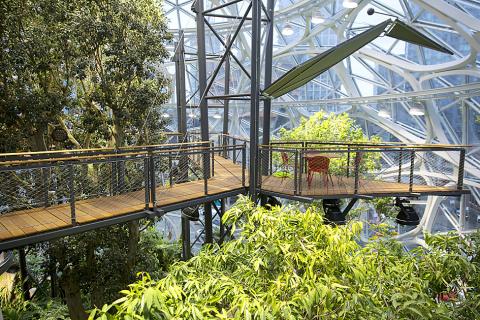
Photo: Bloomberg
“The question I got back was: ‘Well, can we have year five on day one?’” said Ron Gagliardo, the project’s lead horticulturalist. “And that’s kind of been our motto ever since.”
The online retailer is scheduled to unveil the spheres tomorrow morning following seven years of planning and construction.
The glass orbs were built to let Amazon workers escape from e-mails, meetings, reports and deadlines to walk along stone paths beside waterfalls, let ferns from South America brush their shoulders and the moist, tropical air fill their lungs.
“It’s always day one” has been Bezos’ mantra ever since he founded his company 24 years ago, and that start-up ethos has remained intact even as Amazon swelled to more than 540,000 employees worldwide and annual revenue of almost US$180 billion.
“Day one” is so integral to Amazon culture that it is the name of the new Seattle tower where Bezos spends most of his working hours.
However, when you are building a conservatory with 40,000 plants from around the world, “day one” would resemble a barren wasteland recovering from a forest fire. So the team of plant specialists, architects and construction workers had to put their own twist on the boss’ catchphrase to create a mature, living environment: “Day one is year five.”
The trickiest part of the project was transporting a 17m tree, nicknamed Rubi (short for Ficus rubiginosa), from a southern California farm to downtown Seattle, where it was hoisted by crane last summer and dropped through a hole in the roof.
Finding and cultivating plants from around the world while simultaneously building their new home was not easy.
The project created 600 full-time jobs from design through construction.
“Accomplishing year five on day one presented a really big challenge for us,” said David Sadinsky, an architect with the firm NBBJ that designed the spheres. “We realized we had to finish the sphere, take part of it back apart, drop the tree in and then put it back together again.”
From the outside, the three connected spheres resemble a glass-and-steel sculpture of a triple-scoop sundae.
The biggest sphere is 27m high and 39.6m wide. Inside, visitors first notice the warm, moist air, about 22°C and 60 percent humidity, compared with the 30 percent humidity in a typical office.
Eyeglasses fog over and sweat beads on foreheads while bodies adjust. Just inside the doors is a five-story “living wall” cascading with greenery.
The climate varies throughout so that visitors can find a “micro-climate” to their liking. The temperature swings as much as 2°C, a big difference in the humid environment, and ventilation systems simulate an outdoor breeze.
Wi-Fi is available for those looking to work, as well as small meeting spaces like the “bird’s nest,” perched along the suspension bridge beneath Rubi that resembles a tree fort swaying in the branches.
The spheres can accommodate 800 people at a time, and Amazon is to use employee badges to monitor time spent inside and make sure no one hogs the tree fort. Management wants employees to relax, just not too much.
Besides creating a park-like setting where workers can recharge, the spheres will serve as a recruiting tool, said John Schoettler, who runs Amazon’s global real-estate division and oversaw the project.
Candidates interviewed in the spheres will leave with the impression that Amazon remains a forward-thinking company, he said.
“From the moment we started construction, people would stand on the street corners taking photographs,” Schoettler said. “This structure is about thinking big and thinking long term.”
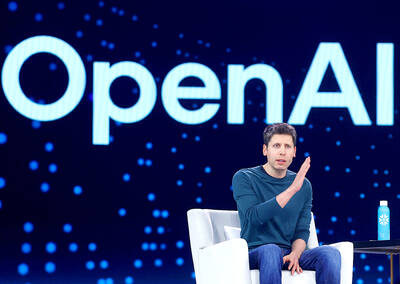
Meta Platforms Inc offered US$100 million bonuses to OpenAI employees in an unsuccessful bid to poach the ChatGPT maker’s talent and strengthen its own generative artificial intelligence (AI) teams, OpenAI CEO Sam Altman has said. Facebook’s parent company — a competitor of OpenAI — also offered “giant” annual salaries exceeding US$100 million to OpenAI staffers, Altman said in an interview on the Uncapped with Jack Altman podcast released on Tuesday. “It is crazy,” Sam Altman told his brother Jack in the interview. “I’m really happy that at least so far none of our best people have decided to take them
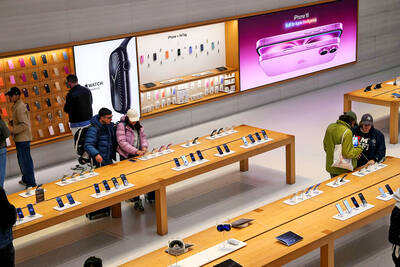
BYPASSING CHINA TARIFFS: In the first five months of this year, Foxconn sent US$4.4bn of iPhones to the US from India, compared with US$3.7bn in the whole of last year Nearly all the iPhones exported by Foxconn Technology Group (富士康科技集團) from India went to the US between March and last month, customs data showed, far above last year’s average of 50 percent and a clear sign of Apple Inc’s efforts to bypass high US tariffs imposed on China. The numbers, being reported by Reuters for the first time, show that Apple has realigned its India exports to almost exclusively serve the US market, when previously the devices were more widely distributed to nations including the Netherlands and the Czech Republic. During March to last month, Foxconn, known as Hon Hai Precision Industry
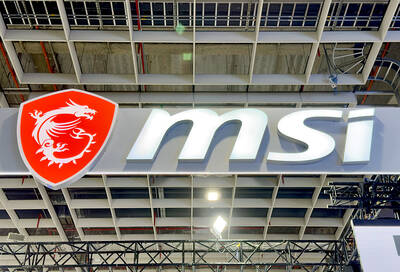
PLANS: MSI is also planning to upgrade its service center in the Netherlands Micro-Star International Co (MSI, 微星) yesterday said it plans to set up a server assembly line at its Poland service center this year at the earliest. The computer and peripherals manufacturer expects that the new server assembly line would shorten transportation times in shipments to European countries, a company spokesperson told the Taipei Times by telephone. MSI manufactures motherboards, graphics cards, notebook computers, servers, optical storage devices and communication devices. The company operates plants in Taiwan and China, and runs a global network of service centers. The company is also considering upgrading its service center in the Netherlands into a
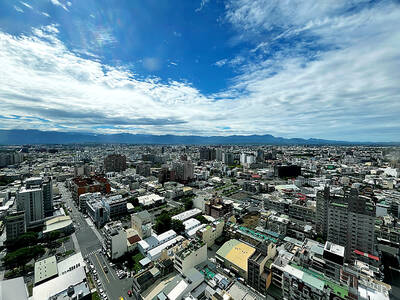
Taiwan’s property market is entering a freeze, with mortgage activity across the nation’s six largest cities plummeting in the first quarter, H&B Realty Co (住商不動產) said yesterday, citing mounting pressure on housing demand amid tighter lending rules and regulatory curbs. Mortgage applications in Taipei, New Taipei City, Taoyuan, Taichung, Tainan and Kaohsiung totaled 28,078 from January to March, a sharp 36.3 percent decline from 44,082 in the same period last year, the nation’s largest real-estate brokerage by franchise said, citing data from the Joint Credit Information Center (JCIC, 聯徵中心). “The simultaneous decline across all six cities reflects just how drastically the market